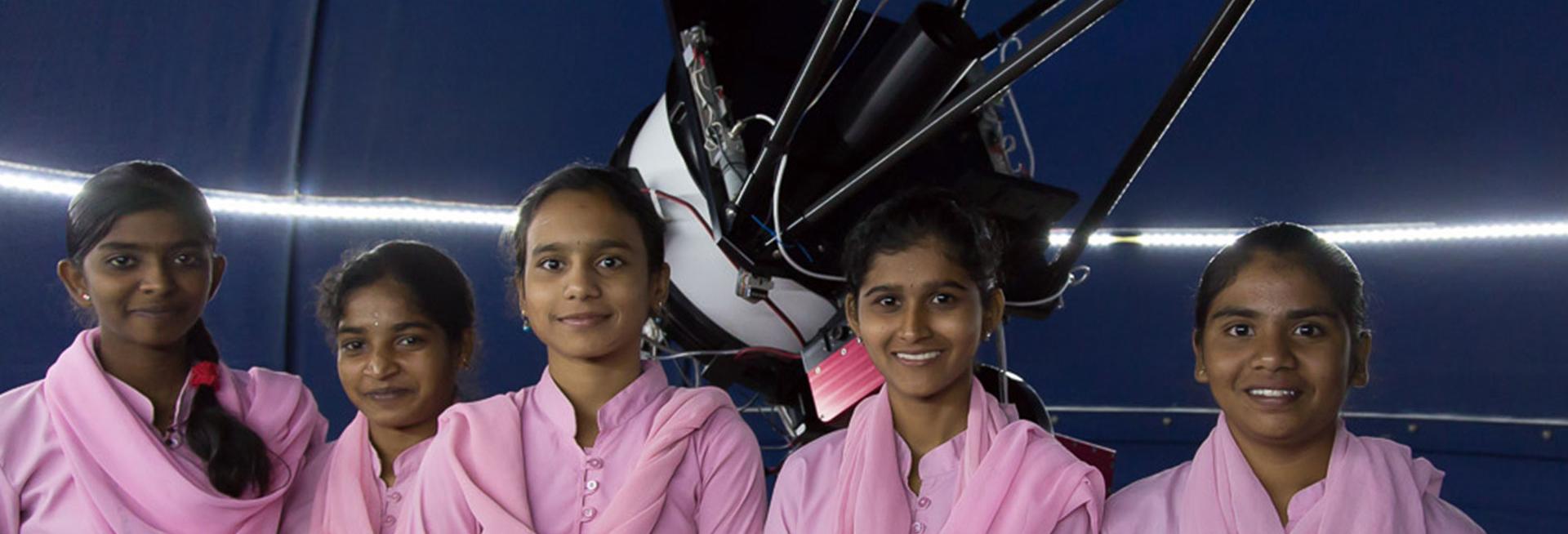Where science meets education...
The Global Jet Watch project combines cutting-edge astrophysics research with unique and inspirational outreach work. The premise of the project is simple enough – a network of round-the-world telescopes delivering round-the-clock spectroscopy as well as photometry to inform research into the causes and effects of accretion to and ejection from near a black hole. However, what sets this project apart is that these observatories aren’t located in research institutes or in the middle of nowhere, rather Professor Katherine Blundell chose to build four of the five in residential schools so that local school children get to take part in, and learn from, her research.
The observatories are located in communities where access to such infrastructure might not otherwise be possible. One of the observatories has been built in a school in southern India. This government school was established so that children of rural families can receive a formal education, it has limited facilities and an ethnographically diverse school community and the project has been an enormous success for the school and surrounding community. There is another oberservatory in a school in South Africa, one in a school in Chile and two in Australia.
Engaging girls with science
The project means that children have access to research-grade instruments including the 0.5-metre telescopes and bespoke spectrographs; it engages young people, and girls in particular, with science. Not only do the young students have the opportunity to carry out research activity and make observations, they also have access to talks about different aspects of science, engineering and being a scientist. More than 2,000 school girls have been introduced to astronomy through Global Jet Watch over 7 years with each academic year introducing a brand new cohort to the project.
Students are trained in person by Professor Blundell during servicing trips and regular contact is maintained using channels such as Skype, WhatsApp and Zoom. After the initial training, students can control the telescope for themselves and explore the night sky – identifying different objects, using the telescopes to do target acquisition, tracking (sidereal and non-sidereal), and guiding to enable deeper observations of fainter targets. After the students' bedtimes, the telescopes are remoted controlled from Oxford and the time-lapse data are relayed to the project team.
Fundamental research goals
The multi-longitudinal locations of the observatories mean that as day breaks in one place, so night falls in another giving the project 24-hours of darkness and so a constant stream of data for Professor Blundell and her group to study.
Extraordinary challenges
Setting up such a project isn’t without its challenges – one of which was the lack of safe and reliable electricity at the site in India, which interrupted observing. Electrical spikes destroyed cameras, computers and device protectors – the solution? To build a solar farm on the school roof, of course! Students were as engaged in this aspect of the project as they were the scientific research and learned first-hand how light energy collected from our nearest star by day is then stored as chemical energy in 2000Ah batteries until it is needed at night to study interesting targets in the rest of the universe.
Once I enter the observatory I forget everything… I feel I have entered heaven.
Student, India
The experience at the observatory truly changed me as a person… it started my journey as a research student.
Student, India
My parents are basically farmers. They don’t know what is ‘space’ and ‘scientists’. After coming here, I was inspired from this telescope… and also from you (Prof Blundell) that I want to become a scientist.
Student, India
Schools visit from Karnataka, Andhra Pradesh, Kerala and Andaman Nicobar… these girls explain well to visiting students and visitors from outside about telescope, solar farm and astronomy.
Physics teacher, India
In 2017, Professor Blundell was appointed OBE in the Queen’s Birthday Honours ‘for services to astronomy and the education of young people’.

